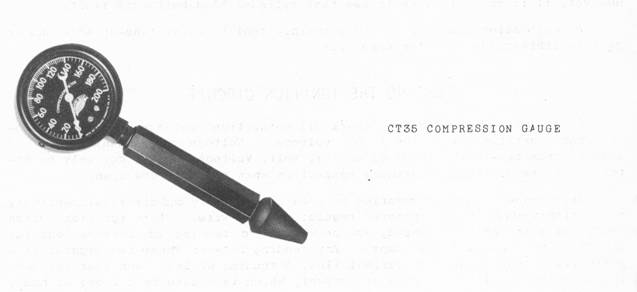previous page: Vacuum Gauge - Tests While Engine is Running
INSTRUCTIONS FOR USE AND PURPOSE OF COMPRESSION GAUGE

The three important elements governing the satisfactory operation of a gasoline engine are compression, ignition, and carburetion. As compression is in no way dependent on carburetion or ignition, and as both of the latter are affected by compression, it is good tune-up practice to check compression first.
To check compression, warm the motor up to operating temperature and then remove all the spark plugs from the motor. This will result in less drain on the battery and higher cranking speed than if only one plug at a time is removed and starting motor must turn the motor against compression.
Hold the rubber plug of the compression gauge in the spark plug, hold tightly enough to prevent leakage at that point and then turn the motor over with the starter with carburetor throttle wide open. The loose pointer of the gauge will go to the highest point reached by the gauge pointer so it is not necessary to watch the gauge while cranking. A half dozen turns of the motor is sufficient to get a reading and further cranking will only wear down the battery. On motors in which compression pressure exceeds 200 lbs., compression loss should not exceed 10 lbs., and on the older motors with compression pressures below 100 lbs., loss should not exceed 5 lbs.
If the compression is low and the rings are at fault, it will usually be indicated by white or light blue smoke in the exhaust, but this is not an infallible guide. If rings are suspected, a quick check can be made by putting a small quantity of heavy oil on top of the piston and permit it to work into the rings. If compression comes up to near normal it will indicate leaky rings, while on the other hand, if compression pressure does not materially vary, it indicates that the leakage is past the valves.
Some of the common causes of valve leakage are insufficient tappet clearance, warped valves, burnt valves, pitted seats, bent stems or gummy stems, broken springs, etc. Each, of course, must be eliminated before a good job can be done in tuning the motor.
If, when refacing valves, enough stock must be removed so that a thin edge is left, a new valve should be put in as a thin valve will overheat and cause pre-ignition and will also warp again in a short time.
Be sure to set valve clearances to manufacturers' specifications. This is important. Sometimes compression losses occur past the cylinder head gasket and the leakage may take place from one cylinder into the next, but this is not common. However, it is good practice to see that cylinder head bolts are tight.
A compression gauge is an indispensable tool in motor tune-up work and is an infallible guide to motor condition.
Table of Contents
The Carburetor and Its Purpose
- Carburetor Construction and Circuits
- Float Circuit
- Low Speed Circuit
- High Speed and Power System
- Pump Circuit
- Choke Circuit
- Anti-Percolation
- Dual Carburetors
- Low Speed Circuit
- High Speed Circuits
- Pump Circuit
- Choke Circuit
- Compound Carburetion
Tune-Up of the Gasoline Engine
- Compression
- Ignition
- Carburetion
- Short Cuts in Trouble Shooting
- Vacuum Gauge Tests While Engine Is Running
- Correct Setting of Ignition Timing With Vacuum Gauge
- Instructions for Use and Purpose Of Compression Gauge
- Testing the Ignition Circuit
- How to Make Test With Analyzer
- Procedure of Test
- Road Testing
